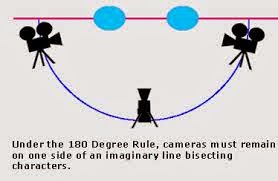The 180 degree rule states that the camera(s) should remain the same side of the 'imaginary line.' The line is situated between both characters within the shot, perpendicular to the camera's viewpoint.
 Breaking the rule could result in audience confusion, as the position of the main character within the shot is always changing. The audience may begin to lose focus as a result of the disorientation and miss vital parts of the film. Crossing the line while filming shifts the actors eye lines, meaning that they do not match.
Breaking the rule could result in audience confusion, as the position of the main character within the shot is always changing. The audience may begin to lose focus as a result of the disorientation and miss vital parts of the film. Crossing the line while filming shifts the actors eye lines, meaning that they do not match.The only way to cross the line without causing audience confusion is to show the camera movement, for example through a pan around the characters. However, once the movement has been shown and the line has been crossed, the only way to cross back over would be to again show the movement, so it is often advised to stay on that side of the line for the rest of the scene.
An example of this is if a character is walking towards the left in one shot, but when the shot is changed to the other side of the 180 degree line the character is then walking to the right of the screen. This means that it is then unclear to the audience where the character is actually going.
This clip shows the 180 degree rule in easy steps and how putting the camera on the other side of the line will stop the focus of eye-line match.
No comments:
Post a Comment